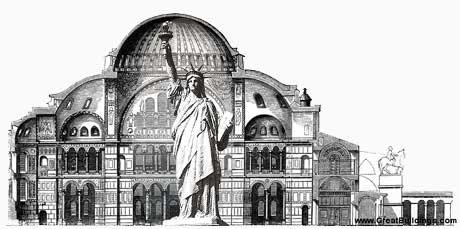More than green, an environmental building
It cost $1.2 Billion, required 40 years to construct and has stood its ground against earthquakes, continental drift, invasions and aerial bombing. It was once the great symbol of Constantine's empire and named for the patron saint of Istanbul it is the Hagia Sophia, Αγία Σοφία and she may be about to lose her crown as the most expensive building ever erected, but not her fabled place in history. Greener satellite photo 
Earlier this month The World Trade Center Memorial Foundation announced that the projected cost of the Ground Zero Memorial in south Manhattan had risen to nearly $1 billion, twice the figure first proposed by Governor Pataki. Architects Michael Arad and Peter Walker plans for the memorial called "Reflecting Absence", is to be funded in part by donations that have so far grown to just $130 million.
As controversy swirls around the design for the site and costs continue to ramp up we thought this might be a good time to examine another great building in antiquity, the Hagia Sophia completed in December 537. Originally built of recycled stone on the site of an ancient church The Ayasofya Museum, as it is now known, was constructed as the seat of the Orthodox patriarch of Constantinople and a principal setting for imperial ceremonies. During the Latin Occupation (1204-1261) the church became a Roman Catholic cathedral. It was converted to a mosque after the Fall of Constantinople to the Ottoman Turks.
This building is more than just history however, it symbolizes what a people, a culture deems most important about their relationship with the natural world. When the Emperor Constantine envisioned his great hall of power and statehood he envisioned more than just a place of worship he saw the wonder of his building rising up to the heavens as both a seat of secular, administrative power and an icon for the faithful, their solemn contract with nature and God.
The architects chosen were among the greatest of their time a mathematician named Anthemius of Tralles and a physicist, Isidorus of Miletus. Constantine charged them with an impossible task, build something that has never been achieved before, a building for the millenia. Other public buildings built before and since were of two varieties then. One, after the fashion of the Greek Classic style was based on squares or rectangles, often adding a curved end wall called a basilica, these buildings were the temples that became template for the Christian legacy of cathedral building.
The second of the common building styles, equally important to society were oval or round structures. These were usually reserved for shows of administrative authority and most often crowned by a dome. The Hagia Sophia was to combine both forms thus proclaiming at once the divine authority and the secular power of Constantine and his namesake city on the Bosporus, Constantinople.
Anthemius and Isadorus proposed a building, which would eventually rise more than 180 feet above the city. Placed inside Hagia's cavernous interior, the statue of liberty would barely brush its dome with her torch. Their revolutionary concept, which solved the puzzle of supporting a dome on four straight walls of a square, was to create massive rectangular halls standing against the exterior of each of the four supporting walls. The strength of these galleries absorbs the pressure of the dome's weight pushing out on the support walls and redirects it onto the foundation. The building requires no interior supporting structure; its massive dome seemingly floats between heaven and earth on a series of delicately arched windows.
The novel construction requirements necessitated development of a host of new materials and technologies many of which may still be found in use today. Lime mortar, a mixture of sand, quicklime cement and water, is extremely dense and thus heavy when set. To lighten the weight of the dome and at the same time strengthen the bonding capacity of the mortar the masons mixed bits of shattered brick into the wet mortar. Less dense than the mortar and randomly aligned, the broken fragments strengthened the mortar just as oriented stranded board is stronger than solid wood.
Hagia represented at the time new methods of design and construction as well as a marked change in the concept of building as machine and a multifunctional use that included but was not restricted throughout its many reincarnations to uses, which its builders could never have conceived. Unlike the pyramids before it or the Coliseum in Rome The Hagia Sophia’s great contribution to history is that for 1500 years it has been not just a symbol of an emperor’s greatness but rather a continuously functioning, resource for a variety of human activities and habitat. The great building of Constantine’s vision continues to point the way for 21st century designers that perhaps the greatest purpose for any building is adaptive reuse. In that regard The Ayasofya may be the greenest building on earth.
by Harlan Weikle
Greener Magazine

Earlier this month The World Trade Center Memorial Foundation announced that the projected cost of the Ground Zero Memorial in south Manhattan had risen to nearly $1 billion, twice the figure first proposed by Governor Pataki. Architects Michael Arad and Peter Walker plans for the memorial called "Reflecting Absence", is to be funded in part by donations that have so far grown to just $130 million.
As controversy swirls around the design for the site and costs continue to ramp up we thought this might be a good time to examine another great building in antiquity, the Hagia Sophia completed in December 537. Originally built of recycled stone on the site of an ancient church The Ayasofya Museum, as it is now known, was constructed as the seat of the Orthodox patriarch of Constantinople and a principal setting for imperial ceremonies. During the Latin Occupation (1204-1261) the church became a Roman Catholic cathedral. It was converted to a mosque after the Fall of Constantinople to the Ottoman Turks.
This building is more than just history however, it symbolizes what a people, a culture deems most important about their relationship with the natural world. When the Emperor Constantine envisioned his great hall of power and statehood he envisioned more than just a place of worship he saw the wonder of his building rising up to the heavens as both a seat of secular, administrative power and an icon for the faithful, their solemn contract with nature and God.
The architects chosen were among the greatest of their time a mathematician named Anthemius of Tralles and a physicist, Isidorus of Miletus. Constantine charged them with an impossible task, build something that has never been achieved before, a building for the millenia. Other public buildings built before and since were of two varieties then. One, after the fashion of the Greek Classic style was based on squares or rectangles, often adding a curved end wall called a basilica, these buildings were the temples that became template for the Christian legacy of cathedral building.
The second of the common building styles, equally important to society were oval or round structures. These were usually reserved for shows of administrative authority and most often crowned by a dome. The Hagia Sophia was to combine both forms thus proclaiming at once the divine authority and the secular power of Constantine and his namesake city on the Bosporus, Constantinople.
Anthemius and Isadorus proposed a building, which would eventually rise more than 180 feet above the city. Placed inside Hagia's cavernous interior, the statue of liberty would barely brush its dome with her torch. Their revolutionary concept, which solved the puzzle of supporting a dome on four straight walls of a square, was to create massive rectangular halls standing against the exterior of each of the four supporting walls. The strength of these galleries absorbs the pressure of the dome's weight pushing out on the support walls and redirects it onto the foundation. The building requires no interior supporting structure; its massive dome seemingly floats between heaven and earth on a series of delicately arched windows.
The novel construction requirements necessitated development of a host of new materials and technologies many of which may still be found in use today. Lime mortar, a mixture of sand, quicklime cement and water, is extremely dense and thus heavy when set. To lighten the weight of the dome and at the same time strengthen the bonding capacity of the mortar the masons mixed bits of shattered brick into the wet mortar. Less dense than the mortar and randomly aligned, the broken fragments strengthened the mortar just as oriented stranded board is stronger than solid wood.
Hagia represented at the time new methods of design and construction as well as a marked change in the concept of building as machine and a multifunctional use that included but was not restricted throughout its many reincarnations to uses, which its builders could never have conceived. Unlike the pyramids before it or the Coliseum in Rome The Hagia Sophia’s great contribution to history is that for 1500 years it has been not just a symbol of an emperor’s greatness but rather a continuously functioning, resource for a variety of human activities and habitat. The great building of Constantine’s vision continues to point the way for 21st century designers that perhaps the greatest purpose for any building is adaptive reuse. In that regard The Ayasofya may be the greenest building on earth.
by Harlan Weikle
Greener Magazine



4:50 PM









<< Home